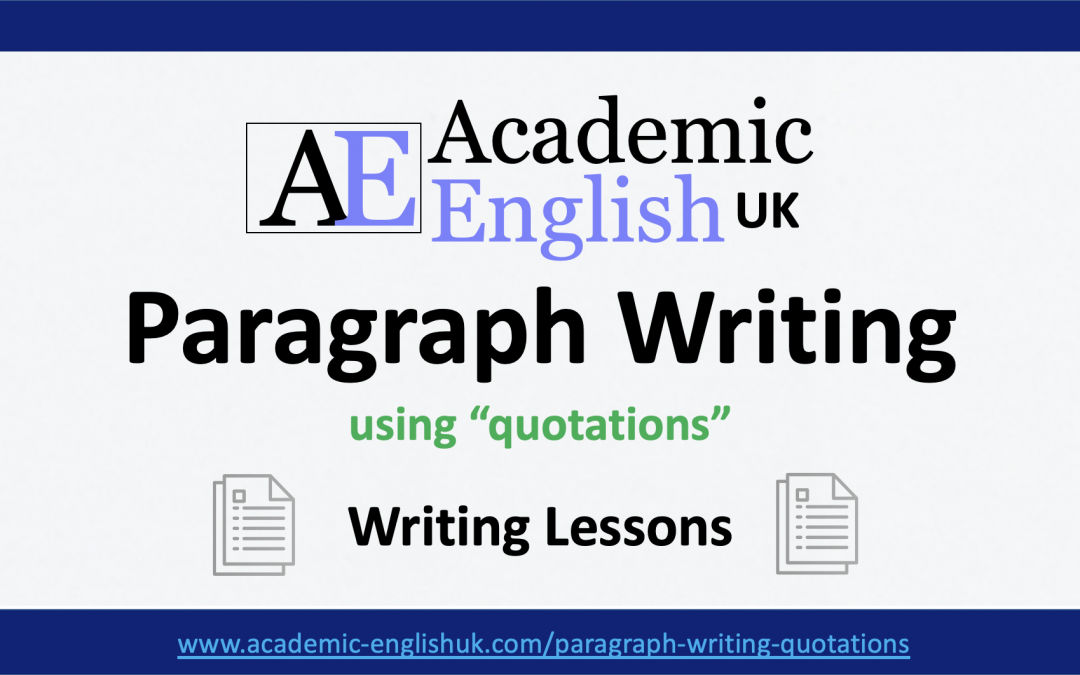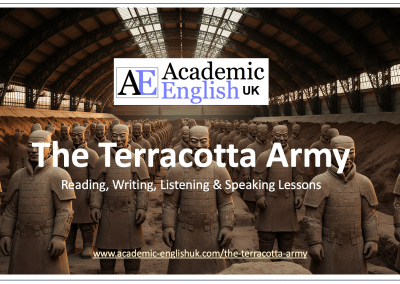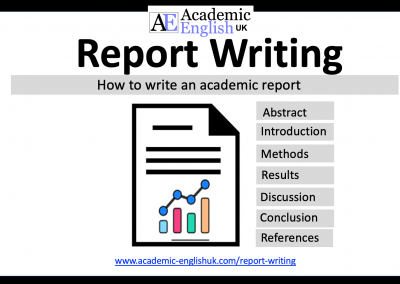Paragraph Writing: “Quotations”
What is paragraph writing with quotations?
Paragraph writing with quotations are writing lessons to practice a range of key writing skills:
- Identifying a position or opinion on a given topic.
- Reading ten quotations and identifying the ones that support the student’s position.
- Choosing three quotations to write a 120-180 word paragraph.
- Following the conventions of paragraph structure (topic sentence, development, examples, concluding sentence).
- Paraphrasing the quotations into a cohesive paragraph.
- Referencing the selected sources using in-text citations.
These lessons can be easily adapted to suit higher or lower levels.
- Lower levels: reduce the number of quotes.
- Higher levels: write a complete essay.
Paragraph Writing Downloads
Click on any link to be taken to the download
Lesson Example
Task: Write a paragraph on the following: ‘The benefits of AI on the future of work far outweigh the negatives’. Use accurate in-text citation and appropriate paraphrasing.
Chosen Quotations
1.’One of the foremost benefits of AI is its ability to automate tasks that were once time-consuming and labour-intensive. AI-powered automation is becoming increasingly sophisticated, enabling businesses to streamline operations, cut costs, and allocate resources more efficiently’ (HBR, 2022).
7. ‘New jobs will be created as traditional jobs disappear. Reskilling and upskilling will become normal employment practice creating numerous opportunities working in AI such as machine learning engineers, data analysts and cyber security experts (McKinsey Study, 2018).
9. ‘Customer service has evolved significantly thanks to AI-driven chatbots and virtual assistants. These systems can handle routine inquiries, troubleshoot problems, and provide real-time assistance, enhancing the overall customer experience’ (Medium, 2023).
The benefits of AI on the future of work far outweigh the disadvantages through two key areas: automation and job creation. The most important function of AI is the reduction of human error through automation. According to HBR (2022), AI can perform everyday repetitive tasks far more efficiently than humans leading to faster decision making and increased productivity. Chatbots and virtual assistants are a good illustration of efficiency whereby routine enquiries can be handled 24/7 providing better customer service and freeing up staff for more creative problem-solving work (Medium, 2023). AI also brings benefits in job creation, as shown in the McKinsey Report (2018), which emphasises that upskilling and reskilling will become normal employment practice as AI creates new careers in areas like machine learning engineers, data analysts and cyber security experts. Overall, although AI may lead to a transformation of existing jobs, it offers new employment opportunities. The automation of repetitive tasks, the emergence of new sectors and the demand for AI-related skills will be the key benefits of the future of work.
Copyright: Academic English UK
The benefits of AI on the future of work far outweigh the disadvantages through two key areas: automation and job creation. The most important function of AI is the reduction of human error through automation. According to HBR (2022), AI can perform everyday repetitive tasks far more efficiently than humans leading to faster decision making and increased productivity. Chatbots and virtual assistants are a good illustration of efficiency whereby routine enquiries can be handled 24/7 providing better customer service and freeing up staff for more creative problem-solving work (Medium, 2023). AI also brings benefits in job creation, as shown in the McKinsey Report (2018), which emphasises that upskilling and reskilling will become normal employment practice as AI creates new careers in areas like machine learning engineers, data analysts and cyber security experts. Overall, although AI may lead to a transformation of existing jobs, it offers new employment opportunities. The automation of repetitive tasks, the emergence of new sectors and the demand for AI-related skills will be the key benefits of the future of work.
Paragraph Questions
1) Is there a topic sentence? What is the topic? What is/are the controlling ideas?
2) Is there a main argument?
3) Which quotes were used?
4) Is it logical and clear? How has the paragraph been organised?
5) Is there an example?
6) Is there a concluding sentence? What is concluded?
7) How are the sources incorporated?
The benefits of AI on the future of work far outweigh the disadvantages through two key areas: automation and job creation. The most important function of AI is the reduction of human error through automation. According to HBR (2022), AI can perform everyday repetitive tasks far more efficiently than humans leading to faster decision making and increased productivity. Chatbots and virtual assistants are a good illustration of efficiency whereby routine enquiries can be handled 24/7 providing better customer service and freeing up staff for more creative problem-solving work (Medium, 2023). AI also brings benefits in job creation, as shown in the McKinsey Report (2018), which emphasises that upskilling and reskilling will become normal employment practice as AI creates new careers in areas like machine learning engineers, data analysts and cyber security experts. Overall, although AI may lead to a transformation of existing jobs, it offers new employment opportunities. The automation of repetitive tasks, the emergence of new sectors and the demand for AI-related skills will be the key benefits of the future of work.
Paragraph Questions
1) Is there a topic sentence? What is the topic? What is/are the controlling ideas?
Yes. Topic: AI on the future of work. Controlling ideas: automation and job creation.
2) Is there a main argument?
Yes – benefits outweigh the disadvantages.
3) Which quotes were used?
Quote 1 / Quote 9 / Quote 7.
4) Is it logical and clear? How has the paragraph been organised?
Yes – logical. Automation > efficiency > example (chatbots 24/7) > human focus on creative tasks + job benefits > upskilling & reskilling > new careers.
5) Is there an example?
Yes: chatbots and virtual assistants are a good illustration of…
6) Is there a concluding sentence? What is concluded?
New employment opportunities as AI takes over repetitive tasks.
7) How are the sources incorporated?
According to HBR (2022)… / … problem-solving work (Medium, 2023) / as shown in the McKinsey Report (2018) ), which emphasises that…
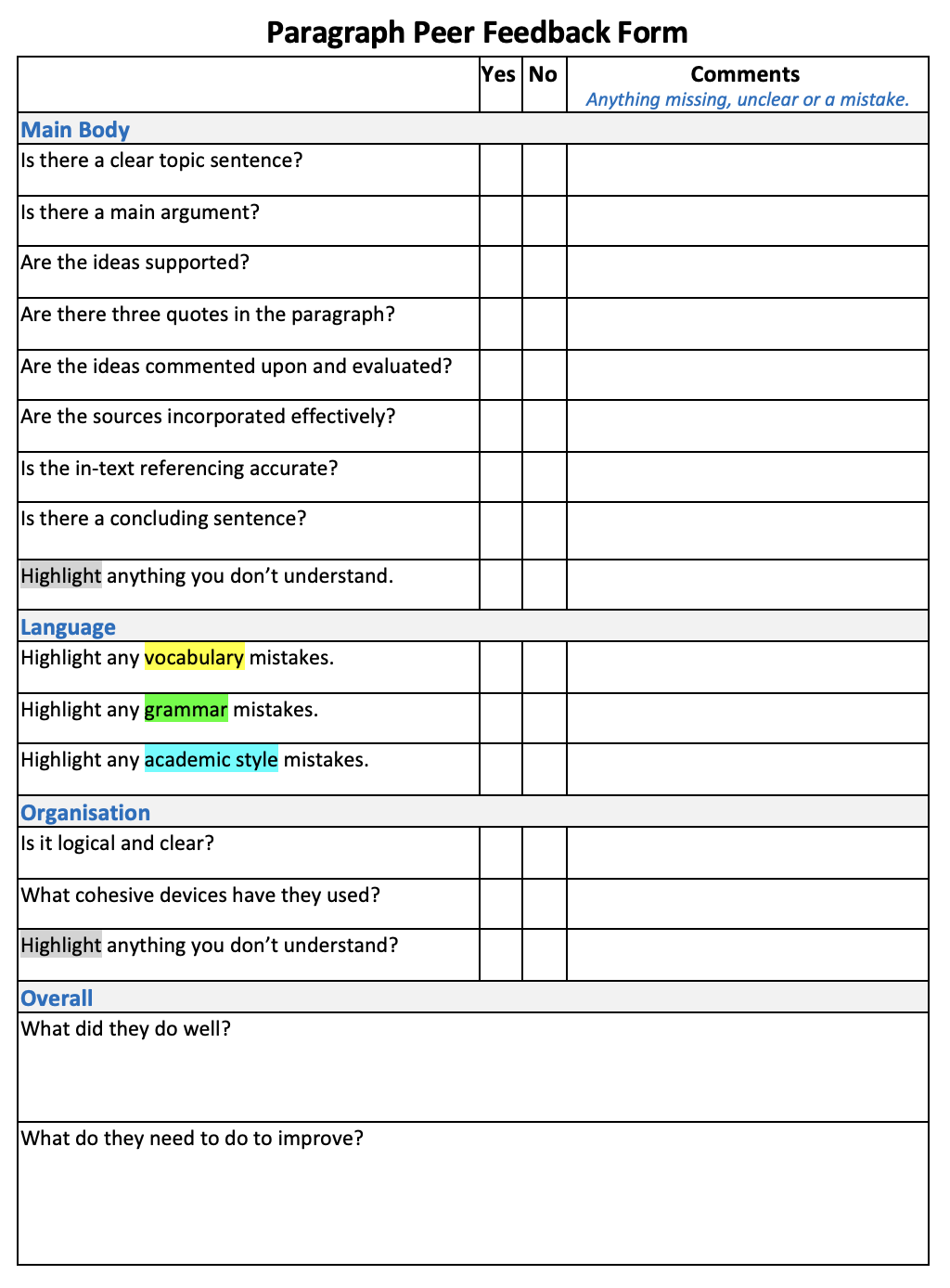
An introduction to paragraph writing using quotations
If you can’t access this YouTube video in your country, go here
Video Worksheet: click here
Downloads
Paragraph Writing: Artificial Intelligence
Paragraph Writing with Quotations: Artificial Intelligence (new 2024)
This lesson has been designed to help students select a number of quotations based on AI that they paraphrase and reference as part of a paragraph writing exercise. The worksheet includes ten quotations to choose from as well as a sample paragraph to analyse. Example. Level: ***** [B1/B2/C1] TEACHER MEMBERSHIP / INSTITUTIONAL MEMBERSHIP
*
Paragraph Writing 1: ChatGPT
Paragraph Writing with Quotations: ChatGPT (new 2024)
This lesson has been designed to help students select a number of quotations based on ChatGPT that they paraphrase and reference as part of a paragraph writing exercise. The worksheet includes ten quotations to choose from as well as a sample paragraph to analyse. Example. Level: ***** [B1/B2/C1] TEACHER MEMBERSHIP / INSTITUTIONAL MEMBERSHIP
*
Paragraph Writing 2: Capitalism
Paragraph Writing with Quotations: Capitalism (new 2024)
This lesson has been designed to help students select a number of quotations based on capitalism that they paraphrase and reference as part of a paragraph writing exercise. The worksheet includes ten quotations to choose from as well as a sample paragraph to analyse. Example. Level: ***** [B1/B2/C1] TEACHER MEMBERSHIP / INSTITUTIONAL MEMBERSHIP
*
Paragraph Writing 3: Circular Economy
Paragraph Writing with Quotations: Circular Economy (new 2024)
This lesson has been designed to help students select a number of quotations based on the circular economy that they paraphrase and reference as part of a paragraph writing exercise. The worksheet includes ten quotations to choose from as well as a sample paragraph to analyse. Example. Level: ***** [B1/B2/C1] TEACHER MEMBERSHIP / INSTITUTIONAL MEMBERSHIP
*
Paragraph Writing 4: Eco Cities
Paragraph Writing with Quotations: Ecological Cities (new 2024)
This lesson has been designed to help students select a number of quotations based on eco cities that they paraphrase and reference as part of a paragraph writing exercise. The worksheet includes ten quotations to choose from as well as a sample paragraph to analyse. Example. Level: ***** [B1/B2/C1] TEACHER MEMBERSHIP / INSTITUTIONAL MEMBERSHIP
*
Paragraph Writing 5: Energy Drinks
Paragraph Writing with Quotations: Energy Drinks (new 2024)
This lesson has been designed to help students select a number of quotations based on energy drinks that they paraphrase and reference as part of a paragraph writing exercise. The worksheet includes ten quotations to choose from as well as a sample paragraph to analyse. Example. Level: ***** [B1/B2/C1] TEACHER MEMBERSHIP / INSTITUTIONAL MEMBERSHIP
*
Paragraph Writing 6: Gross Domestic Product
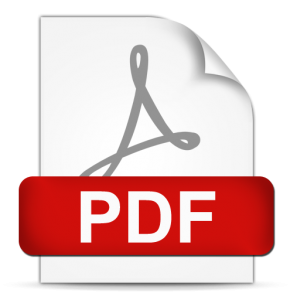 Paragraph Writing with Quotations: Gross Domestic Product (GDP) (new 2024)
Paragraph Writing with Quotations: Gross Domestic Product (GDP) (new 2024)
This lesson has been designed to help students select a number of quotations based on GDP that they paraphrase and reference as part of a paragraph writing exercise. The worksheet includes ten quotations to choose from as well as a sample paragraph to analyse. Example. Level: ***** [B1/B2/C1] TEACHER MEMBERSHIP / INSTITUTIONAL MEMBERSHIP
*
Paragraph Writing 7: Generation Gap
Paragraph Writing with Quotations: Generation Gap (new 2024)
This lesson has been designed to help students select a number of quotations based on generation gap that they paraphrase and reference as part of a paragraph writing exercise. The worksheet includes ten quotations to choose from as well as a sample paragraph to analyse. Example. Level: ***** [B1/B2/C1] TEACHER MEMBERSHIP / INSTITUTIONAL MEMBERSHIP
*
Paragraph Writing 8: Social Media
Paragraph Writing with Quotations: Social Media (new 2024)
This lesson has been designed to help students select a number of quotations based on social media that they paraphrase and reference as part of a paragraph writing exercise. The worksheet includes ten quotations to choose from as well as a sample paragraph to analyse. Example. Level: ***** [B1/B2/C1] TEACHER MEMBERSHIP / INSTITUTIONAL MEMBERSHIP
*
Paragraph Writing 9: Surveillance Technology
Paragraph Writing with Quotations: Surveillance Technology (new 2024)
This lesson has been designed to help students select a number of quotations based on surveillance technology that they paraphrase and reference as part of a paragraph writing exercise. The worksheet includes ten quotations to choose from as well as a sample paragraph to analyse. Example. Level: ***** [B1/B2/C1] TEACHER MEMBERSHIP / INSTITUTIONAL MEMBERSHIP
*
Paragraph Writing 10: Vaping
Paragraph Writing with Quotations: Vaping (new 2024)
This lesson has been designed to help students select a number of quotations based on vaping that they paraphrase and reference as part of a paragraph writing exercise. The worksheet includes ten quotations to choose from as well as a sample paragraph to analyse. Example. Level: ***** [B1/B2/C1] TEACHER MEMBERSHIP / INSTITUTIONAL MEMBERSHIP
*
Paragraph Analysis Download
Paragraph analysis: corporate social responsibility (CSR)
This worksheet provides a step-by-step guide the key components of a paragraph. It analyses a basic paragraph on corporate social responsibility (CSR) through structure, topic, cohesion, referencing and stance. It also includes a writing practice on globalisation. Example. Level: ***** [B1/B2/C1] TEACHER MEMBERSHIP / INSTITUTIONAL MEMBERSHIP
Academic Paragraph Structure Lesson (Block or Point-by-Point)
Academic paragraph analysis: block or point-by-point 
This lesson helps students identify the key elements in paragraph writing. It focuses on two paragraph structures: block and point-by-point. Students analyse each paragraph for structure, controlling ideas & key terms, in-text referencing, cohesion and author’s stance. It also includes two writing exercises. Example. Level: ***** [B2/C1] TEACHER MEMBERSHIP / INSTITUTIONAL MEMBERSHIP
*
Reading & Writing Argument: essay [Mergers & Acquisitions]
Topic: Mergers & Acquisitions. Two short texts (included) – students read the texts, make notes of key arguments, and write a 400-600 word essay using in-text referencing and paraphrasing. The essay should follow (block / point-by-point structure) more info. Lesson includes teacher notes, outline & a model essay. Example Level ***** [B2/C1] / Webpage link. TEACHER MEMBERSHIP / INSTITUTIONAL MEMBERSHIP
*
Economic Inequality Lesson PDF Book
AMAZING VALUE – Five lessons in one book. Introduction, definition, reading test & summary writing, 1 x lecture listening, [extra reading text] & seminar / example [TEACHER MEMBERSHIP]
*

